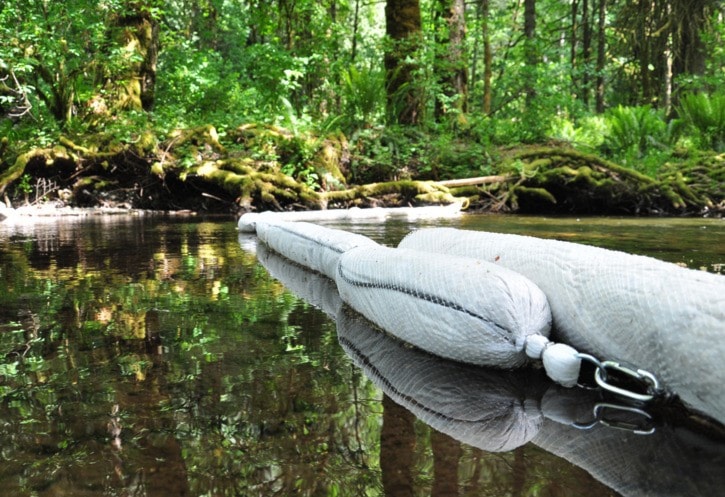Goldstream River is healing and seeing signs of life after being flushed with gasoline in April, but the ecosystem isn’t out of the woods yet.
Much of the 42,000 litres of gasoline and 600 litres of diesel fuel spilled from a crashed Columbia Fuels tanker on April 16 evaporated away, but even two months later, residual fuel remains glued to river stones and in pockets near the stream bank.
Agencies involved in the cleanup – Ministry of Environment, First Nations, Columbia Fuels environmental consultants and fish hatchery staff – are seeing an increased level of insect life on the river and decreasing levels of trace fuels. They also haven’t seen more dead fish that first appeared in droves in the days after the spill.
“All the numbers have been trending down,” said Graham Knox, manager of the environmental emergency program with the Ministry of Environment. “The latest survey, the First Nation representatives said there is definitely an improvement (in water quality). It’s a good sign the fuel is breaking down naturally.”
Since April, the environment ministry has overseen continuous water sampling in seven locations along the river, with each location having three samples and one in the riverbed sediment.
That work has recorded occasional contaminant spikes, resulting in the ministry ordering Columbia Fuels to conduct intensive well testing in two riverbank areas. Indeed, one area about 100 metres downriver from the crash site still wreaks of gasoline and is draped in white fuel-absorbing booms.
“Columbia Fuels is testing all around to see if they got all (the fuel) or not,” he said. “They may have to pump it out or dig it out.”
As days grow longer and hotter, hydrocarbon breakdown should accelerate, Knox said. But if residual fuel remains when August rolls in, they may consider using low-pressure hoses to flush fuel from the river.
“If we do flush the channel, we’ll do it before salmon enter the river system,” Knox said. “We don’t want to do that if we don’t have to. We want to do everything with minimal disturbance.”
What’s more worrying and potentially problematic over the long term is the geology under the spill site on the west side of the Trans-Canada Highway. The crashed truck released its fuel into a culvert piped directly into the river. But some was absorbed into the earth and fractured bedrock below.
Unknown volumes of fuel could be creeping along millmetre wide cracks in the bedrock, and Knox said detecting the location and extent of that flow is extremely difficult. Absorbent booms string long stretches river on either side the crash location, just in case.
“Fuel can move down the cracks and may end up flowing to upstream or downstream locations,” Knox said. “Unless you go through the crack with a well, you don’t see it. It’s very challenging for the folks doing this to find where it is.”
Fractured bedrock remains such a concern, Ministry of Environment contaminated site staff are directly overseeing that aspect of the cleanup. Until it’s clear no fuel is migrating through the bedrock, Columbia won’t be issued a certificate of compliance, Knox said.
“The process may take a long time. We hope it won’t enter the river, but its very difficult to tell,” he said. “But what’s positive is we haven’t seen it in the river yet. If it was there, we think it would move more quickly and show up.”
Columbia Fuels is reimbursing motorists stranded in the wake of the highway closure, is working on a compensation agreement with Saanich Tribes and is paying for cleanup costs and ministry staff time. It still faces a lump sum payout for damage to the environment under what is called a natural resource damage assessment (NRDA).
Knox said the province doesn’t have a set procedure for assessing a NRDA, so the ministry is looking at payment calculation models from Washington State and Florida.
The models take into account the toxicity of fuel and variables relating to the extent of environmental damage to come up with a dollar figure. Knox guesses that could be $500,000 to $1.5 million for Goldstream River. That money would be used on future restoration projects, as determined by First Nations, hatchery staff and government agencies.
“The formula is based on a lot of factors, but it also considers the fact we can’t quantify all the damage to the ecosystem, that we can’t create the whole picture,” Knox said.
“Columbia Fuels recognizes restoration is needed and they are willing to pay for that. I’m optimistic we’ll come up with a number appropriate for restoration and that will compensate the public for damage done.”
Andrea Voysey, a spokesperson for Columbia Fuels, said the agreement between the company and the five Saanich tribes is confidential, but formally establishes involvement of First Nations in the cleanup effort.
"It is a relationship agreement," Voysey said. "It recognizes the special interests of First Nations with Goldstream park."
Stranded drivers compensated
Drivers stranded on either side of the Malahat over April 16 and 17 made a total of 525 claims with Columbia Fuels, and 68 were rejected. Of the 457 accepted, most were for food and overnight lodging, Voysey said.
Of the 68 rejected, Voysey said most were claims unrelated to travelling or the wrong time frame. About 750 people total inquired about making a claim.
editor@goldstreamgazette.com
